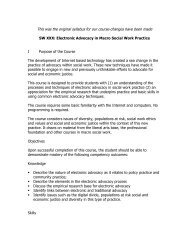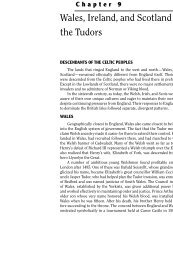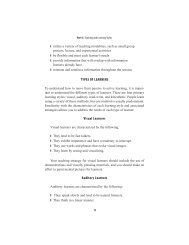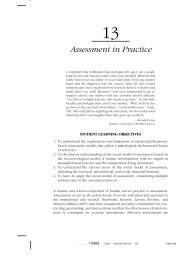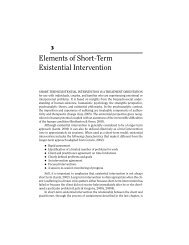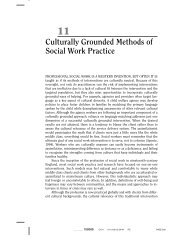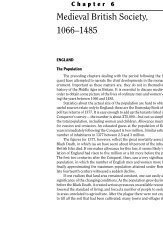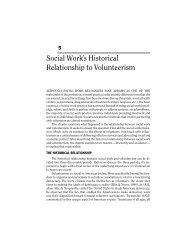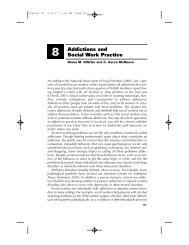Society and Economy in England, 1715–1763 - Lyceum Books
Society and Economy in England, 1715–1763 - Lyceum Books
Society and Economy in England, 1715–1763 - Lyceum Books
Create successful ePaper yourself
Turn your PDF publications into a flip-book with our unique Google optimized e-Paper software.
60 Part I The Age of the L<strong>and</strong>ed Oligarchy<br />
Foreign trade cont<strong>in</strong>ued to grow <strong>in</strong> all its branches—exports, imports, <strong>and</strong><br />
reexports. The “new trades,” such as the import<strong>in</strong>g <strong>and</strong> reexport<strong>in</strong>g of tobacco,<br />
sugar, l<strong>in</strong>ens, calicoes, <strong>and</strong> slaves, grew steadily <strong>in</strong> comparison to the old staple<br />
export, f<strong>in</strong>ished woolens. The basic pattern of English trade was shift<strong>in</strong>g, for while<br />
the proportion of English imports from northern Europe still stood at over 30 percent<br />
<strong>in</strong> 1750, the English over time imported less from Europe <strong>and</strong> more from the<br />
East Indies, the West Indies, <strong>and</strong> North America. Similarly, exports <strong>and</strong> reexports<br />
to Europe (especially to Spa<strong>in</strong> <strong>and</strong> Portugal) rema<strong>in</strong>ed of great importance, but<br />
shipp<strong>in</strong>g to North America <strong>and</strong> the East Indies won a larger share. Overall, English<br />
overseas trade doubled between 1700 <strong>and</strong> 1760, accelerat<strong>in</strong>g from a growth rate of<br />
about 1 percent a year <strong>in</strong> 1700 to 2 percent a year <strong>in</strong> 1760—a remarkable performance<br />
for a pre<strong>in</strong>dustrial society. Engl<strong>and</strong> <strong>in</strong> the early eighteenth century was no<br />
Third World economy.<br />
This foreign trade, as well as the coastal trade <strong>in</strong> coal <strong>and</strong> foodstuffs, made shipp<strong>in</strong>g<br />
a formidable bus<strong>in</strong>ess. In the 1740s, for <strong>in</strong>stance, more than two hundred<br />
ships (most of them English) worked the tobacco trade alone. Because of the Navigation<br />
Acts, more than four-fifths of all ships call<strong>in</strong>g at British ports were British<br />
owned; <strong>and</strong> British shipp<strong>in</strong>g tonnage more than doubled between 1700 <strong>and</strong> 1770.<br />
London cont<strong>in</strong>ued to be the largest port by far <strong>and</strong> to grow <strong>in</strong> size—to more than<br />
700,000 people <strong>in</strong> 1760, probably a quarter of whom worked <strong>in</strong> the port trades. London’s<br />
<strong>in</strong>satiable dem<strong>and</strong> drew <strong>in</strong> goods from most of the British Isles: cattle from<br />
Wales <strong>and</strong> Scotl<strong>and</strong>, fruits <strong>and</strong> vegetables from the Thames Valley <strong>and</strong> the West<br />
Country, gra<strong>in</strong>s from the Midl<strong>and</strong>s <strong>and</strong> East Anglia, coal from Newcastle, <strong>and</strong> iron<br />
from Sussex, the western Midl<strong>and</strong>s, <strong>and</strong> eastern Wales. The new trades also stimulated<br />
the expansion of other cities, Liverpool, Bristol, <strong>and</strong> Glasgow <strong>in</strong> particular.<br />
Liverpool, the center of the slave trade, grew from about five thous<strong>and</strong> people <strong>in</strong><br />
1700 to thirty thous<strong>and</strong> <strong>in</strong> 1750. Thus, London’s share of Engl<strong>and</strong>’s exp<strong>and</strong><strong>in</strong>g<br />
trade decl<strong>in</strong>ed as prov<strong>in</strong>cial wealth grew.<br />
London was the hub of an <strong>in</strong>ternal market that <strong>in</strong>corporated most of the<br />
regions of Engl<strong>and</strong>, as well as parts of Irel<strong>and</strong>, Wales, <strong>and</strong> Scotl<strong>and</strong>. This market<br />
was to be a key force <strong>in</strong> <strong>in</strong>tegrat<strong>in</strong>g the economies of the British Isles. The degree<br />
of commercialization <strong>in</strong> Engl<strong>and</strong> <strong>and</strong> the average Englishman’s love of cash <strong>and</strong><br />
profits must not be underestimated. This was true of l<strong>and</strong>owners <strong>and</strong> farmers as<br />
well as townsmen. The s<strong>in</strong>ews of Engl<strong>and</strong>’s market economy were becom<strong>in</strong>g<br />
tougher. London’s f<strong>in</strong>ancial <strong>in</strong>stitutions grew <strong>in</strong> size <strong>and</strong> number: <strong>in</strong> addition to the<br />
Bank of Engl<strong>and</strong>, the East India Company (1709) <strong>and</strong> the South Sea Company<br />
(1711) were chartered <strong>in</strong> part to f<strong>in</strong>ance the national debt. A craze for jo<strong>in</strong>t-stock<br />
companies <strong>and</strong> speculation <strong>in</strong> their stock soared until 1720, when the South Sea<br />
Company’s <strong>in</strong>flated stock collapsed. Thereafter, laws severely restricted jo<strong>in</strong>t-stock<br />
company foundation, but the commercial sector found its own ways of rais<strong>in</strong>g capital<br />
<strong>and</strong> facilitat<strong>in</strong>g transactions, as private merchants <strong>and</strong> attorneys <strong>in</strong> grow<strong>in</strong>g<br />
numbers performed bank<strong>in</strong>g functions. The notoriously poor roads began to be<br />
improved by means of private turnpike trusts that f<strong>in</strong>anced their construction <strong>and</strong><br />
ma<strong>in</strong>tenance by tolls. Water transport—slower but cheaper than road haulage—



